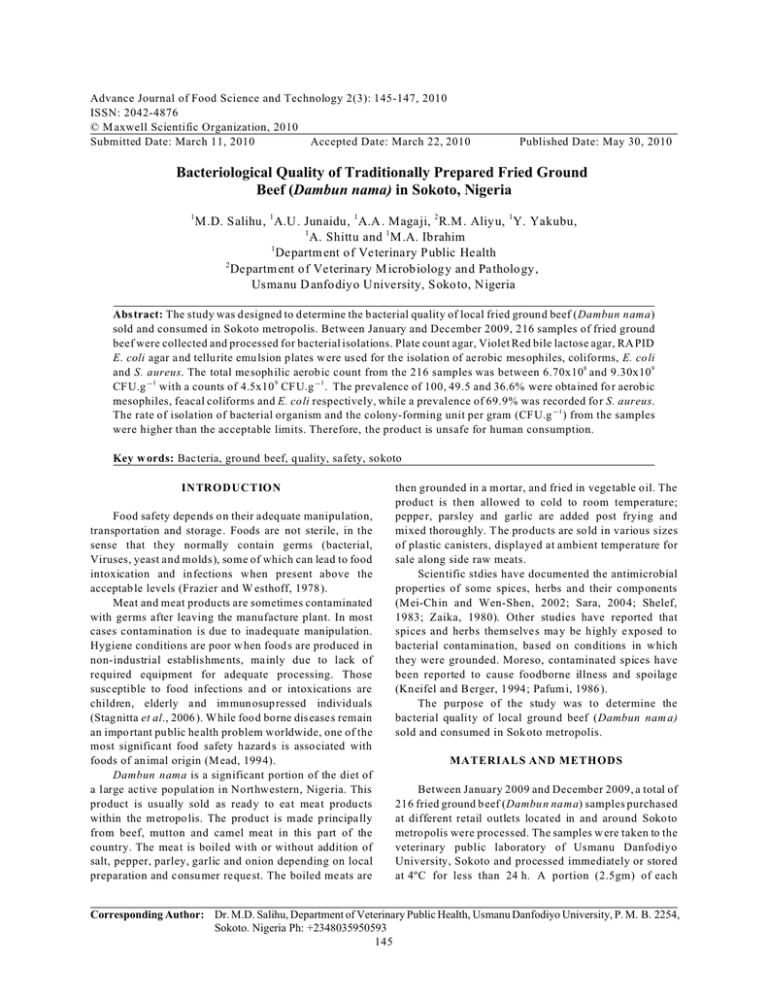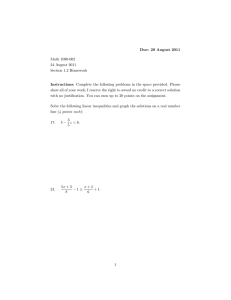Advance Journal of Food Science and Technology 2(3): 145-147, 2010
advertisement

Advance Journal of Food Science and Technology 2(3): 145-147, 2010 ISSN: 2042-4876 © M axwell Scientific Organization, 2010 Submitted Date: March 11, 2010 Accepted Date: March 22, 2010 Published Date: May 30, 2010 Bacteriological Quality of Traditionally Prepared Fried Ground Beef (Dambun nama) in Sokoto, Nigeria 1 M.D. Salihu, 1 A.U . Junaidu, 1 A.A . Magaji, 2 R.M . Aliyu, 1 Y. Yakubu, 1 A. Shittu and 1 M.A. Ibrahim 1 Departm ent of Veterinary Public Health 2 Departm ent of Veterinary M icrobiolog y and Patholo gy, Usmanu D anfodiyo University, Soko to, Nigeria Abstract: The study was designed to d etermine the bacterial quality of local fried ground beef (Dambun nama) sold and consumed in Sokoto metropolis. Between January and December 2009, 216 samples of fried ground beef were collected and processed for bacterial isolations. Plate count agar, Violet Red bile lactose agar, RA PID E. coli agar and tellurite emu lsion plates w ere used for the isolation of aerobic mesophiles, coliforms, E. coli and S. aureus. The total me soph ilic aerob ic count from the 216 samples was between 6.70x108 and 9.30x109 CFU.gG 1 with a counts of 4.5x10 9 CFU.gG 1 . The prevalence of 100, 49.5 and 36.6% were obtained fo r aerob ic mesophiles, feacal coliforms and E. coli respectively, while a prevalence of 69.9% was recorded for S. aureus. The rate of isolation of bacterial organism and the colony-forming unit per gram (CFU.gG 1 ) from the samples were higher than the acceptable limits. Therefore, the product is unsafe for human consumption. Key w ords: Bac teria, ground beef, quality, safety, sokoto INTRODUCTION Food safety depe nds o n their adequate manipulation, transportation and storage . Foods are not sterile, in the sense that they normally contain germs (bacterial, Viruses, yeast and molds), some of which can lead to food intoxication and infections when present above the acceptab le levels (Frazier and W esthoff, 1978). Meat and meat products are sometimes contaminated with germs after leaving the manufacture plant. In most cases contamination is due to inadequate manipulation. Hygiene conditions are poor w hen food s are produced in non-industrial establishme nts, ma inly due to lack of required equipment for adequate processing. Those susceptible to food infections an d or intoxications are children, elderly and im mun osup ressed individuals (Stagnitta et al., 2006 ). W hile food borne diseases remain an impo rtant public health problem worldwide, one of the most significant food safety h azard s is asso ciated with foods of an imal origin (M ead, 1994). Dambun nama is a significant portion of the diet of a large active population in Northwestern, Nige ria. This product is usually sold as read y to eat meat produ cts within the metropo lis. The product is made p rincipally from beef, mutton and camel meat in this part of the country. The meat is boiled with or without addition of salt, pepper, parley, garlic and onion depending on local preparation and consu mer request. The boiled me ats are then grounded in a mortar, and fried in vege table oil. The product is then allowed to cold to room temperature; pepper, parsley and garlic are added post frying and mixed thorou ghly. T he pro ducts are sold in various sizes of plastic canisters, displayed at ambient temperature for sale along side raw meats. Scien tific stdies have documented the antimicrobial properties of some spices, herbs and their comp onents (Mei-Ch in and Wen-Shen, 2002; Sara, 2004; Shelef, 1983; Zaika, 1980). Other studies have reported that spices and herbs themselves may be h ighly exposed to bacterial contamination, based on con ditions in which they were grounded. Moreso, contaminated spices have been reported to cause foodborne illness and spoilage (Kneifel and Berger, 1994; Pafum i, 1986 ). The purpose of the study was to determine the bacterial quality of local ground beef (Dambun nam a) sold and consumed in Sok oto metropolis. MATERIALS AND METHODS Between January 2009 and December 2009, a total of 216 fried ground b eef (Dambu n nama) samples purchased at different retail outlets located in and around Sokoto metro polis were processed. The samples w ere taken to the veterinary public laboratory of Usmanu Danfodiyo University, Sokoto and processed immediately or stored at 4ºC for less than 24 h. A portion (2.5gm) of each Corresponding Author: Dr. M.D. Salihu, Department of Veterinary Public Health, Usmanu Danfodiyo University, P. M. B. 2254, Sokoto. Nigeria Ph: +2348035950593 145 Adv. J. Food Sci. Technol., 2(3): 145-147, 2010 Table 1: Prevalence the bacterial isolates from D a m bu n na m a Isolates N um be r p os itiv e (% ) Aerobic mesophiles 216(100) Faecal coliforms 107(49.5) E. co li 79(36.6) Staphylococcus aureus 151(69.9) sample was placed aseptically into a separate sterile stomacher bag containing 22.5 ml of 0.1% sterile peptone water and homogenized in a stomacher. The suspension was then serially diluted at ten fold in 0.1% sterile peptone water for bac terial analyses. These suspensions were seeded in different culture media. Counts of me soph ilic aerob es w ere do ne in plate count agar incubated at 37ºC for 24 h. Only those plates containing 30 and above c olonies w ere considered for the counts. The bacterial counts were obtained by multiplying the mean number of colonies by the inverse of the dilution. Results were reported as colony-form ing units per gram of sample s (CF U.gG 1 ) as described by Feng et al. (1998 ). Feacal coliforms counts were carried out on violet Red bile lactose agar incu bated at 44ºC for 24 h. Colonies were considered as round red to pink. E. coli counts w ere carried out on RAPID E. coli agar. Typical colonies w ere considered as violet to pink. Presumptive E. coli colonies were checked for Gram reaction and characterized by Kligler test. Staphylococcus aureus counts were carried out on tellurite emulsion plates and incubated at 35ºC for 24 to 48 h. Typical colonies (black surrounded by Clear zones) were considered positive. all the samples were from traditionally proc essed products and the total aerobic counts far exceed the prescribed microbiological safety limits. This is so because the products are produced in a non-industrial premise. The implication of the findings is that the prod uct is not safe for human consu mption, since all the samples (100%) were positive for aerobic counts excee ding th e acceptable limits. The prevalence of E. coli in this study was 36.6%, which is higher than previously reported in roasted beef (Suya) and roasted poultry meat in the same study area (Magaji et al., 2002; Abdulkadir et al., 2007). The prevalence of E. coli in this study is however, lower than 90% reported in Johannesburg (Meara et al., 1977), and 58.26% from gound beef in Argentna (Stagnitta et al., 2006). The average count of 2.2x104 CFU.gG 1 recorded was higher than 1.4±0.6 log CFU.gG 1 previously reported by Scanga et al., 2000 ). Cou nts of E. coli that exceed the limits established by regulations h ave b een frequently reported throughout the world. Most of the enterobacteria present in meat come from feacal contamination. The isolation rate of 69.9% for S. aureus was however higher than previous reports (Magaji et al., 2002; Americh et al., 2003; A bdulkad ir et al., 2007; Nozha et al., 2008). The high bacterial counts from the products (Dambun nama) from this study is gene rally attributed to the filthy environment, poor personal hygiene of the processors, retailers and the use of con taminated utensils during processing, packag ing. There could b e possible cross contamination of the finished product from adjacent raw meat through unclean hands of the handlers and/or flies. The addition of spices and hot season after processing may have significantly increased the amount of bacterial flora in the meat products. This is because the spices may be contaminated with variety of bacterial organisms. Contaminated sp ices ha ve be en rep orted to cause foodborn illness and spoilage of food (Kneifel and Berger, 19 94; Pafum i, 1986 ). The finding from this study is of serious pu blic health concern, as most of the isolates have been reported to cause various health problems (Foodborne infction and intoxications) in humans. There is the possibility of transfer of resistant properties to the consum ers, if antibiotic resistant organisms are ingested with the products. There is the need to enlighten the producers and retailers of the product on the importance of environmental and p erson al hyg iene at all times, to display finished products separately from raw meats. RESULTS AND DISCUSSION The preva lence of the different bacterial fro m this study is shown in table 1. The total me soph ilic aerob ic counts from the 216 samples ranged between 6.70 x10 8 and 9.30x109 CFU.gG 1 , with a mean count of 4.5x109 CFU.gG 1 . The prevalence of aerobic bacteria was 100%. The counts of feacal coliforms in the 216 samples ranged between 10 3 and 10 5 CFU.gG 1 , 109 (49.5%) of the samples were positive. Out of the 2 16 sam ples, 79(36.6% ) were positive for E.coli and coun ts ranged between 10 2 and 10 5 CFU.gG 1 . S. aureus, was isolated from 151 (69.9%) of the samples with counts ranging between 10 5 and 10 7 CFU.gG 1 . The evaluation of bacterial agents can be a good indicator of the bacterial quality of meat food products, as aerob ic flora has been used as criteria to predict the mean life of products. The microorganisms can be used as indicators of inadequate product manufacturing and /or handling. There are no available regulatory standards for the microbiological safety criteria for locally (nonindustrial) prepared read to eat foods to compare with our findings. How ever, to evaluate the hygienic quality of the samples studied our results were compa red to Moroccan regulatory standards for microbiological safety criteria for foods (Moroccan Department order, 2004). According to these regulations, the aerobic plate counts, feacal coliforms, S. aureus, should not exceed 5.7, 2 and 2 log CFU.g G 1 respectively in raw ground meats. In our study 146 Adv. J. Food Sci. Technol., 2(3): 145-147, 2010 The findings from this study imply that the product (Dambun nana) is unsa fe and constitutes a food safety risk to the numerous ever-increasing consumers. If measures are not put in place, there may be a possible outbreak of food poisoning and or foodborne infections due to consumption of the contaminated product (Dambun nana). This may lead to seriou s econom ic and public health problem. Meara, P.J., L.N. Melmed and R.C. Cook, 1977. Microbiological investigation of m eat w holesale premises and b eef carcasse s in Joh annesbu rg. J. S. Afr. Vet. Assoc., 48(4): 255-260. Mead, G.C., 1994. M icrobiological hazards from red meat and their control. Br. Food J., 96: 33-36. Mei-Chin, Y. an d C. W en-Shen, 2002 . Antioxidant and antimicrobial effects of four garlic-derived organosulfur compounds in ground beef. M eat Sci., 63: 23-28. M oroccan Department order No. 624-04, 2004. Relative of animal and animal origin foods. Official Bull., 5214: 727-745. Nozha, C., F. Ingrid, K. Bouchra, S. Ba dri, I. Carle, H. Ennaji, B. Bouchrif, M. Hassar and H. Karib, 2008. Microbial quality control of raw ground beef and fresh sausage in casablanca (M orocco). J. Environ. Hlt., 71(4): 51-55. Pafumi, J., 1986. Assessmen t of microbiological quality of species and herds. J. Food Protect., 49: 958-963. Scanga, J.A., A.D. Grona, K.E. Belk, J.N. Sofos, G . R . Bell i n ge r a n d G . C . S m i th , 2 0 0 0. Microbiological contamoination of raw beef trimming and ground beef. Meat Sci., 56: 145-152. Sara, B., 2004. Essential oils: Their antibacterial properties and potential applications in foods- A Review. Int. J. Food Microbiol., 94: 223-253. Shelef, L.A., 1983. Antimicrobial effects of spices. J. Food Safety, 6: 29-44. Stagnitta, P.V., B. Micalizzi and A.M. Stefanini de Guzman, 2006. Prevalence of some bacteria, ye ast, and molds in meat foods in san luis, Argentina. Cen t. Eur. J. Pub. Health, 14(3): 141-144. Zaika, L.L., 1980. Spices and herbs: their antimicrobial activity and its determination. J. Food Safety, 9: 97-118. REFERENCES Abd ulkadir, U.J., D.S. Mohamm ed, A.M . Abd ullahi, S. Aminu, G.L. Mohammed and I. Enerenwa, 2007. Bacteriological contamination of fried and roasted poultry meat sold and hawked in Sokoto , Nigeria. J. Med. Pharm. Sci., 3(2): 80-85. Americh, T., B. Martin, M. Garriga and M. Hugas, 2003. Microbial quality and direct PCR identification of lactic acid bacteria and non-pathogenic staphylococci from artisanal low-acid sausages. Appl. Environ. Microbiol., 69: 4583-4594. Feng, P., S.D . W eagant and M.A. Grant, 1998. Enumeration of E. coli and the Co liform B acteria in Bacetreriological Analytical Manual. Food and Drug Adminstration, 8th Edn., Revision A. (monograph on the internet). Retrieved from: http://www.cfsan.fda. gov/-ebam/bam-4.html. (Accessed date: April 13, 2009) Frazier, W.C. and D.C. Westhoff, 1978. Food Infections And Intoxications From Microbiological Origin. In: Food Microbiology, 3rd Edn., Zaragoza Editorial Acribia S.A ., pp: 413 (In Spa nish). Kneifel, W. and E. Berger, 1994. Microbial criteria of random samples of spices and herbs retailed on the Austrian market. J. Food Protect., 57: 893-901. Magaji, A.A., M.D. Salihu and B.L. Donbou, 2002. Bacteriological evaluation of roasted Beef “suya” in Sokoto metropolis. Proceedings of the 39th Annual congress of the NVM A, Sokoto, pp: 131-133. 147



